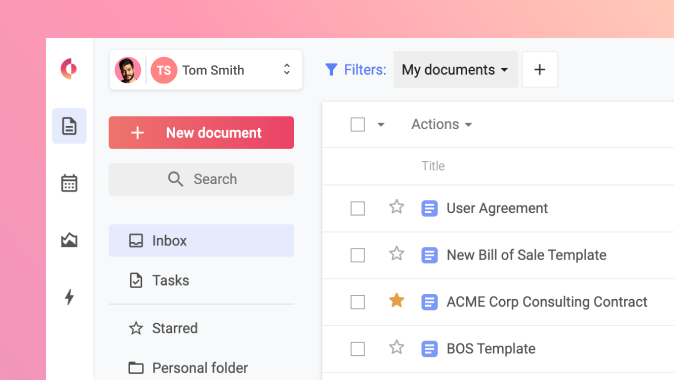How Procurement Teams Achieve Risk and Compliance Maturity through Contracts
This is the second in a series of four posts for Procurement teams.
Read Part One.
Identify
Too often contracts are filed and forgotten, relying on the protective language lawyers draft to stay fines or avoid risk. Problem is, change is a constant. As global regulations proliferate and expectations increase, an audit, or risk assessment, as painful as it can be, is a necessary step in due diligence—helping hold suppliers accountable and saving money in the long run by reducing risk and improving processes and controls.
Rule of thumb: review often and monitor performance. Easier said than done unless using an online contract management tool. Contract management solutions not only make performing a successful contract audit easier, they make implementing changes and enforcing them easier too, giving an organization faster processes and the flawless compliance that accelerates growth.
Review
As changes are made to accommodate terms, sweeten deals, and move negotiations along, to different provisions in the contract, it’s important Procurement teams are 1) aware of these changes as they are being made, regardless of who’s making them, and 2) loops in their Legal department to ensure terms and conditions are optimal, products are received on time, and there’s no risk or liability deemed unreasonable.
What used to be a long, arduous process is now streamlined and simplified. Using templates, standard with most contract management platforms, contracts can be created with the click of a button and contain all the necessary components. Online negotiation eliminates version control issues, as parties never have to download-edit-email a document, and all edits, redlines, and changes are tracked. Approval workflows automatically loop in Legal when necessary, no chasing, no waiting.
Analyze
Does your organization know all the supplier contracts that will expire in the next 30, 60, or 90 days? Does it measure the risk of its portfolio of contracts? Does it have a list of its own violations of existing contracts? Does it know how many contracts will automatically renew this year and whether that renewal is good for the organization? Where strategic opportunities are? Opportunities for better negotiation, terms, etc? Does it know how many contracts it has in general? If your Procurement contracts manager left would you be left scrambling?
A well managed contract portfolio can control expenses, and protect revenue, stopping financial leakage that can hurt profitability and expose the organization to litigation, failed counterparties, and compliance violations. It ensures value is realized and expectations are met. In short, a well managed contract portfolio can save money.
With a CLM (Contract Lifecycle Management) platform approval workflows can help automate compliance, and renewal alerts keep things from falling through the cracks. With an analytics dashboard Procurement organizations can run reports that aggregate data from contract analytics to create a more thorough and complete picture of the business. With this added perspective, Procurement teams are better able to gain new insights, leverage future opportunities, further enhance efficiency, and become more strategic.
Evaluate
Identify which areas to improve and effectively weigh various aspects of contract risk. When an audit is performed and an analysis is complete, it’s the perfect time to assess the full-lifetime value of a contract, prioritize supplier/customer relationships and commitments accordingly, and identify areas that can be automated—are there contracts you can templatize to streamline the process and accelerate cycles? Is there a supplier that is presenting more of a liability than opportunity? Or the reverse? For Procurement teams looking to become more strategic and play a larger role in an organization’s success, there isn’t a better way to bring your A-game to the table.
Tagging and categorizing contracts according to best practices allows targeting contracts close to renegotiation, those that might prevent you from growing profitably, and identifying contracts which are more attractive because they contain repricing opportunities (savings) or previously undiscovered opportunities for growth.
Mitigate
Construct contracts to mitigate risk as much as possible. Applying risk mitigation by avoidance, elimination, transfer, or bearing the risk often involves the creation or modification of contract clauses. Having pre-approved clauses is a key factor for the successful contract risk management of any company. Placing clauses at the template level ensures the appropriate and necessary clauses are always included, regardless of who creates a contract.
Along the same lines as clauses, identify minimum security protocols and standards for vendors and apply them during the vendor selection and contracting process. This includes protocols for cybersecurity, where regulations and best-practices are constantly maturing. Monitor changes to the law and create risk management processes and procedures to protect information, especially when contracting with vendors.
A third important, yet oft overlooked, part of mitigating risk is organizational flexibility. How do you get compliant flexibility, a seeming oxymoron? By automating processes—through templates, approval workflows, and so on.
When Procurement teams are able to quickly complete tasks such as update a template and push the updated information to the right people in seconds, they enable organization-wide agility—able to adapt to changing terms, business climates, and market conditions easily—delivering flawless compliance, and reduce risk without slowing teams or business down.
Manage
Because businesses are constantly changing—new customers, new products, and new regulations—a filing cabinet is no longer (even a hard drive) an acceptable storage option for a company’s most critical business documents. Many companies, with the advent of SaaS, are beginning to look to the Cloud to help manage and store their contracts.
More recent times have seen the advent of Procurement and P2P technology platforms, offering the opportunity for procurement process simplification. However, what is left unaddressed is an integral part of the procurement cycle—full-lifecycle procurement contract management (from origination and in-platform negotiation to a company-wide system of record and analytics). This leaves opportunity and money on the table, and omits an essential component to reconciling speed with compliance.
Visibility and control. Without these, companies will ultimately be forced to either slow down growth or take unnecessary risks. Well-managed contracts can ensure that financial and operational risk is minimized while performance is maximized—increasing process efficiency, reducing costs, and improving visibility.
With centralized contract management processes, putting all people, processes, and contracts in one place, and the aforementioned capabilities (workflows, templates, online negotiation, organization) these platforms take the unknown out.
Neutralize
The quickest way to neutralize a situation is by creating trust and security. Meaning one of the best ways to neutralize or avoid contractual risk is through good, old-fashioned collaboration.
Contract management platforms do this by enabling online, in-document editing and negotiation. It ensures all parties see and accept the clauses and terms of the contract in real-time, making sure everyone agrees to an acceptable, realistic amount of risk up front, while accelerating Procurement cycles, deals, and forming strategic relationships that pay dividends in first access to goods and preferred pricing.
Eliminate risk
There are so many necessary parts to eliminating risk, which are nearly impossible without a robust, integrated solution. Soon, if not already, Procurement’s job will be more about managing the processes, which means having effective processes in place to begin with. When it comes to efficiently eliminating risk, there is no better solution than a platform, with intuitive capabilities integrated into all processes, enabling Procurement to eliminate risk with the push of a button.
Templates can be updated and then refreshed, pushing fresh data in seconds, ensuring everyone who’s using that template to create contracts is compliant. Create checkpoints and build them in as approval workflows within your contract processes. Tailor these steps based on existing workflows, types of contracts, and so on. Use the modern tools available to make contracts and contract management simpler, faster, and easier— for everyone.
If risk can be an opportunity, it’s how it’s managed that makes the difference. Procurement is a vital business function, and well-managed risk can help Procurement teams provide three main areas of value to the rest of the organization, each outlined in the next part of our series.
Want to see how Concord can help your Procurement team?



